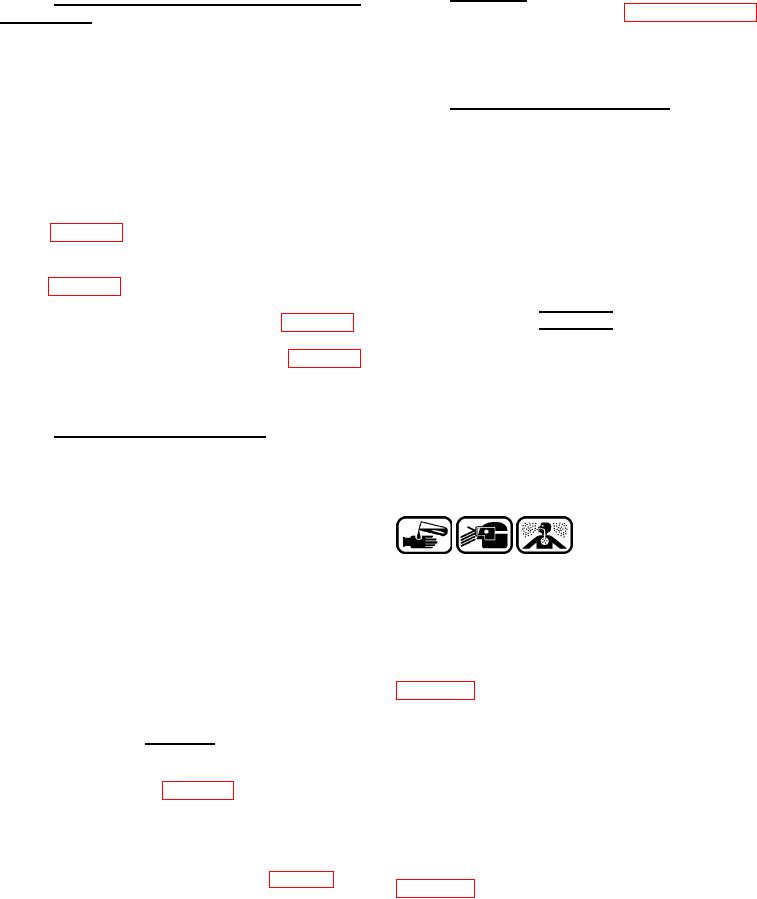
01 March 2005
NAVAIR 01-1A-509-3
TM 1-1500-344-23-3
TO 1-1-689-3
10-4.1. GENERAL. Where possible, the primary
10-3.3. REQUIRED TOOLS, MATERIALS, AND
method of emergency cleaning (paragraph 10-4.2)
EQUIPMENT. Immediate availability of the necessary
shall be used. One of the alternate methods of
corrosion control tools, materials, and equipment will
emergency cleaning shall be used when a sufficient
significantly aid in reducing further damage. Refer to
quantity of fresh water is not available.
material and equipment lists in Volume IV and V. Certain
special items of equipment which will be useful and
10-4.2. PRIMARY CLEANING METHOD. The primary
should be readily available are:
method for removing salt water and fire extinguishing
agents shall be used when a sufficient quantity of fresh
a. Dry Nitrogen Source.
water is available.
b. Dry Air Source.
a. Flush all internal and external areas with clean,
fresh water. Whenever possible, units or components
c. Vented Drying Oven, Forced Air. (Volume IV
that have been removed should be immersed and
and V, Chapter 3)
flushed thoroughly in clean, fresh water. A 55-gallon
drum may be used for this purpose. Tilt the equipment
d. Vented Drying Ovens, Bulb Type. (Volume IV
back and forth to aid in draining off excess water
and V, Chapter 3)
WARNING
e. Hot Air Blowers. (Volume IV and V, Chapter 3)
Compressed air used for drying can create
f. Pump, Backpack. (Volume IV and V, Chapter 3)
airborne particles that may enter the eyes.
Pressure shall not exceed 10 psi. Eye protection
g. Clean Empty 55 Gallon Drums.
is required.
10-3.4. P R O D U C T I O N PLANNING. Whenever
b. Blow off excess water with not more than 10 psi
possible, all salvageable components of the aircraft
air pressure or dry nitrogen. Deflect jet of air off interior,
shall be treated simultaneously. The most experienced
back, and sides of enclosures to diffuse.
personnel available shall be assigned to disassemble
and process the aircraft. This will minimize damage
and ensure that the work is accomplished in a thorough
a n d competent manner. Whenever possible,
examination and evaluation personnel shall be
Compound, Aircraft Cleaning
4
assigned to work with the disassembly and preservation
MIL-PRF-85570
crew. This enables unreclaimable items to be scrapped
immediately and ensures that only areas exposed to
c. (N) (A) If any evidence of salt or fire extinguishing
corrosive agents are disassembled and treated. The
agents remain, a second cleaning action should be
time saved by this procedure may be utilized in
initiated, using a solution of one part Aircraft Cleaning
preserving salvageable components.
Compound, MIL-PRF-85570 Type II (Volume IV,
Chapter 2), to ten parts of distilled water. Scrub the
10-4. EMERGENCY CLEANING PROCEDURES.
affected areas with the solution. Flush thoroughly with
fresh water and drain excess. The equipment may be
CAUTION
immersed in fresh water to aid in removing hidden
contaminants. Tilt the equipment back and forth to aid
Cleaning compounds and solvents identified
in draining excess water.
in Volume IV and V, Chapter 2, may react with
some encapsulants or plastics used to form fire
d. (AF) If any evidence of salt or fire extinguishing
harness tubing, wire coatings, conformal
agents remain, a second cleaning action should be
coatings, gaskets, or seals. Test on a small
initiated, using a solution of one part Aircraft Cleaning
area for softening or other adverse reactions
Compound, MIL-PRF-87937 Type II or IV (Volume V,
prior to general application. Refer to Table 2-4
Chapter 2), to ten parts of distilled water. Scrub the
for further restrictions on these materials.
affected areas with the solution. Flush thoroughly with
fresh water and drain excess. The equipment may be

